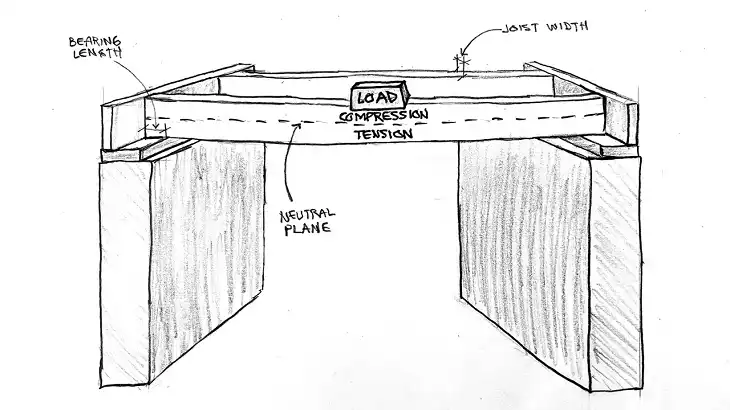Beam Joist Spacing: A Guide to Getting it Right
Choosing the right beam joist spacing is essential to constructing safe, durable floors, ceilings, and decks. Understanding how to measure, select standard spacing, and calculate optimal distance between beams can prevent structural issues and maximize material efficiency.
This article offers a detailed approach to each of these areas, ensuring your building projects remain secure and compliant with industry standards.

How to Measure Joist Spacing
Accurate joist spacing begins with careful measurement. Here’s a step-by-step guide to ensure consistency:
- Identify the Edge of the Structure: Start from one side or edge of the framework, such as a wall or beam end. This will serve as your reference point.

- Mark the Center of the First Joist: With a measuring tape, find the center of the first joist and mark it. This initial mark is crucial since the remaining measurements will depend on it.
- Measure from Center to Center: Joist spacing is measured “on-center,” which means you measure from the center of one joist to the center of the next. On-center spacing is often either 12, 16, or 24 inches (30.5 cm, 40.6 cm, or 61 cm), depending on the structural requirements.
- Use a Chalk Line for Accuracy: Once you measure the first few joists, mark them with a chalk line to maintain alignment. This ensures that each subsequent joist is evenly spaced and parallel.
- Double-check Your Measurements: Confirm that each spacing is consistent across the entire framework to avoid issues with stability.
- Account for Load-Bearing Factors: Areas that carry heavier loads, such as stair landings or kitchen floors, may require closer spacing to handle weight distribution.

What is the Standard Beam Spacing?
Beam spacing refers to the distance between two parallel beams and is determined by structural load requirements, material choice, and the type of structure. Generally, these are the standards:
- 12 Inches (30.5 cm) On-Center: Used for heavy-load applications, such as decks and upper-level floors where stability is crucial.

- 16 Inches (40.6 cm) On-Center: Most common in residential buildings, this spacing is suited for standard load-bearing floors and ceilings.

- 24 Inches (61 cm) On-Center: Ideal for light-duty applications, like roof support, where extensive strength isn’t required. However, some caution is needed since greater spacing can create “bounce” or flexibility in the floor.
Below is a quick reference table for beam spacing by load application:
| Application | Spacing (On-Center) | Best for |
| Heavy-load floors | 12 inches (30.5 cm) | Decks, upper floors |
| Standard floors | 16 inches (40.6 cm) | Most residential flooring, ceiling joists |
| Light-duty roofs | 24 inches (61 cm) | Roof structures, low-load floors |
What is the Spacing for Joist Beams?
Joist beams support the floor or ceiling of a structure, distributing weight and maintaining stability. Standard joist spacing depends on the type of load and the material used. Here’s an in-depth look:
12 Inches On-Center: Ideal for areas expecting heavy loads or extensive foot traffic, such as public areas in commercial buildings or kitchens in homes. This spacing provides added strength, supporting both people and heavy appliances.
16 Inches On-Center: The most common spacing for residential flooring, ceilings, and standard rooms. It balances cost-efficiency with load capacity, providing solid support for living areas without needing additional materials.
24 Inches On-Center: Often used for roof structures or less-used floor areas where lower weight support is acceptable. Roof joists, especially in climates with light snowfall, frequently use 24-inch spacing.
Example Calculation for Joist Spacing
If you’re building a residential deck that will bear heavy loads, 12-inch on-center spacing may be necessary. Here’s how to calculate the number of joists:
- Determine Length of Structure: Let’s say your deck is 12 feet long.
- Convert to Inches: 12 feet = 144 inches.
- Divide by Joist Spacing: 144 inches ÷ 12 inches (spacing) = 12 joists required.
For 16-inch spacing, the same deck would require: 144 inches ÷ 16 inches = 9 joists.
How Far Apart Should Each Joist Be?
Finding the right distance between joists depends on factors like load-bearing requirements, material properties, and building codes. General recommendations include:
Assess the Load Requirements: Heavy-duty areas, such as kitchens or commercial floors, need closer joist spacing. For instance, floors with large appliances may need joists placed 12 inches apart.
Account for Material Strength: Joist materials affect how much load can be distributed across a given space. For example, engineered wood, like laminated veneer lumber (LVL), allows wider spacing due to its strength.
Consult Building Codes: Local building codes specify minimum spacing for different applications to ensure safety. For residential floors, codes typically recommend 16-inch on-center spacing. However, some areas may have stricter requirements depending on environmental factors, like snow loads.
Frequently Asked Questions
What is the Standard Spacing for Ceiling Joists?
Ceiling joists typically use 16 inches (40.6 cm) on-center spacing. This standard spacing provides sufficient support for residential applications, although some structures may use 12 inches (30.5 cm) on-center for added load-bearing strength or to support heavier items like insulation, ceiling fans, or additional finishing.
What is the Minimum Space Between Beams?
The minimum space between beams is generally set by building codes and depends on the load requirements. However, for typical residential construction:
Minimum Spacing for Floors and Decks: 12 inches (30.5 cm) on-center.
Minimum Spacing for Ceilings: 16 inches (40.6 cm) on-center.
Conclusion
In summary, beam joist spacing is a balance of structural requirements and material efficiency. It ensures safety, longevity, and comfort in any construction project. Following these guidelines and consulting local building codes can make a substantial difference in the structural integrity and lifespan of your project.






